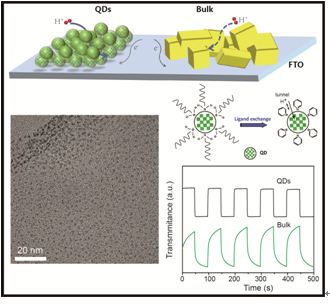The rapid development of devices regarding energy conversion, storage, and saving including lithium batteries, supercapacitors and fuel cells, have attracted a great deal of interest as a potential solution to the ever-increasing energy shortage. A fast electrochemistry with efficient electron and ion transport in electrode materials has always been an ongoing pursuit for the researchers, which also sits at the heart in improving the performance of energy-relative devices. In comparison with traditional bulk electrode materials, zero-dimensional quantum dots (QDs) are ideal and unique with several striking advantageous features, such as small size, large surface-to-volume ratio, and significantly high proportion of surface atoms, which would greatly shorten the diffusion paths of intercalation ions in the solid phase and facilitate intimate contacts between electrode materials and electrolyte/current collector. However, the utilization of QDs as electrode materials in electrochemical reactions remains a formidable challenge, which may be closely related with the low electrochemical activity of most available QD materials, poor conductivity arising from the detrimental insulation of capping ligands, and the interparticle resistance rising with the increasing grain boundaries.
Professor Zhao Zhigang’s group of Suzhou Institute of Nanotech and Nanobionics (SINANO), Chinese Academy of Sciences and Professor Geng Fengxia’s group from Soochow University together carried on a detailed and in-depth research, and made a breakthrough progress in the synthesis of tungsten oxide QDs and their downstream applications in electrochemical devices. They adopted organic tungsten compound as precursor, single-type aliphatic amine as reactant/solvent to successfully obtain uniform-sized WO3-x nanocrystals with an average diameter as low as 1.6 nm, which can be monodispersed in organic solvents showing a strong quantum confinement effect. This work has solved the long-standing issue that the quantum dots of tungsten oxide are either difficult to obtain or the synthesis must be relied on several lattice templates, such as silica and zeolite. Moreover, with a simple ligand-exchange strategy, long-chain aliphatic amine ligand anchored on QDs surface can be replaced with conductive pyridine molecule to endow the QDs with excellent conductivity, with the premise of which a very fast electrochemistry can be ultimately realized. The obtained QD material manifests excellent electrochemical and electrochromic behaviors: (1) surprisingly robust to be charged and discharged without significant distortion in CV profile shape, well keeping the fine structures even at a scan rate up to 500 mV s-1; (2) with a high coloration efficiency of 154 cm2/C and a fast response with both coloration and bleaching within 1 s, superior to tungsten oxide analogue and other inorganic electrochromic materials.
This research work has proved that downsizing electrode material to extremely small particle size, for example, zero-dimensional QDs will significantly improve the efficiency of matter/charge transfer process, and represent a promising application of QD materials into the field of ultra-fast response electrochemical devices. Relative results have been published in Advanced Materials (Volume 26, Issue 25, pages 4260–4267, July 2, 2014).


